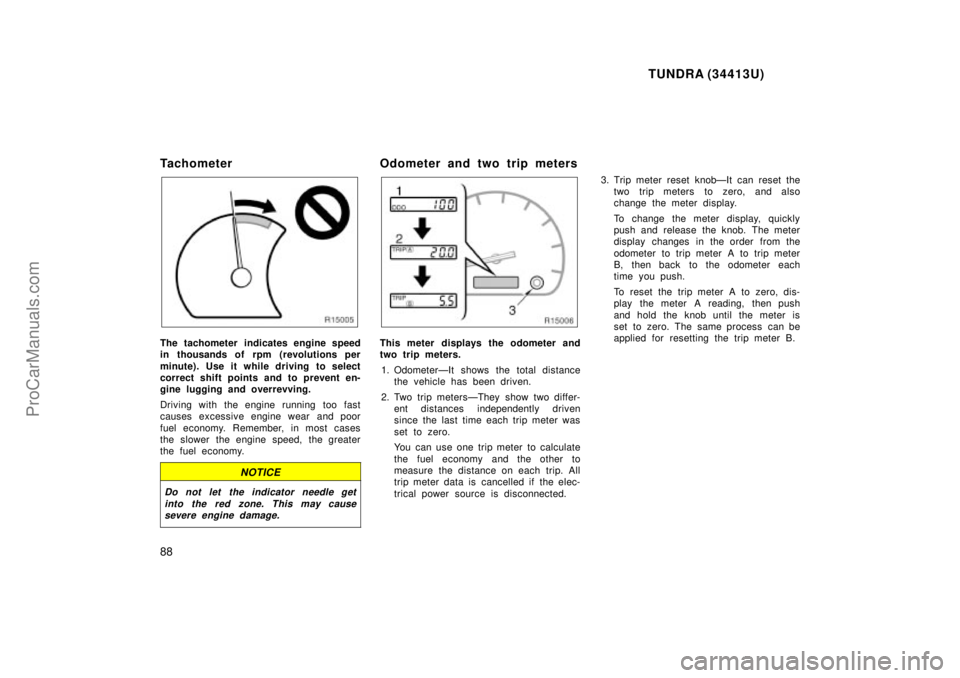Page 4 of 283
TUNDRA (34413U)
4
1. Oil pressure gauge
2. Service reminder indicators and indicator lights
3. Tachometer 4. Speedometer
5. Voltmeter
6. Fuel gauge
7. Trip meter reset knob
8. Odometer and two trip meters
9. Engine coolant temperature gauge
Instrument cluster overview
�
With tachometer
ProCarManuals.com
Page 5 of 283
TUNDRA (34413U)
5
1. Engine coolant temperature gauge
2. Service reminder indicators and indicator lights 3. Speedometer
4. Fuel gauge
5. Trip meter reset knob
6. Odometer and two trip meters
�
Without tachometer
ProCarManuals.com
Page 85 of 283

TUNDRA (34413U)
85
Part 1
OPERATION OF
INSTRUMENTS AND
CONTROLSÐ
Chapter 1- 5
Gauges, Meters and
Service reminder
indicators
�Fuel gauge
� Engine coolant temperature
gauge
� Oil pressure gauge
� Volt m et er
� Tachometer
� Odometer and two trip meters
� Service reminder indicators and
warning buzzers
Fuel gauge
With tachometer
Without tachometer
The gauge works when the ignition
switch is on and indicates the approxi-
mate quantity of fuel remaining in the
tank.
Nearly fullÐNeedle at Fº
Nearly emptyÐNeedle at Eº
It is a good idea to keep the tank over
1/4 full.
This fuel gauge has a non- return type
needle which remains at the last indicated
position when the ignition switch is turned
off.
If the fuel level approaches Eº or the low
fuel level warning light comes on, fill the
fuel tank as soon as possible.
On inclines or curves, due to the move-
ment of fuel in the tank, the fuel gauge
needle may fluctuate or the low fuel level
warning light may come on earlier than
usual.
If the fuel tank is completely empty, the
malfunction indicator lamp comes on. Fill
the fuel tank immediately.
The indicator lamp goes off after driving
several times. If the indicator lamp does
not go off, contact your Toyota dealer as
soon as possible.
ProCarManuals.com
Page 88 of 283

TUNDRA (34413U)
88
Tachometer
The tachometer indicates engine speed
in thousands of rpm (revolutions per
minute). Use it while driving to select
correct shift points and to prevent en-
gine lugging and overrevving.
Driving with the engine running too fast
causes excessive engine wear and poor
fuel economy. Remember, in most cases
the slower the engine speed, the greater
the fuel economy.
NOTICE
Do not let the indicator needle getinto the red zone. This may causesevere engine damage.
Odometer and two trip meters
This meter displays the odometer and
two trip meters.
1. OdometerÐIt shows the total distance the vehicle has been driven.
2. Two trip metersÐThey show two differ- ent distances independently driven
since the last time each trip meter was
set to zero.
You can use one trip meter to calculate
the fuel economy and the other to
measure the distance on each trip. All
trip meter data is cancelled if the elec-
trical power source is disconnected. 3. Trip meter reset knobÐIt can reset the
two trip meters to zero, and also
change the meter display.
To change the meter display, quickly
push and release the knob. The meter
display changes in the order from the
odometer to trip meter A to trip meter
B, then back to the odometer each
time you push.
To reset the trip meter A to zero, dis-
play the meter A reading, then push
and hold the knob until the meter is
set to zero. The same process can be
applied for resetting the trip meter B.
ProCarManuals.com
Page 245 of 283

TUNDRA (34413U)
245
Check the tires regularly for damage
such as cuts, splits and cracks. If any
damage is found, consult with a techni-
cian and have the tire repaired or re-
placed.
Even if the damage does not appear seri-
ous, a qualified technician should examine
the damage. Objects which have pene-
trated the tire may have caused internal
damage.
Any tires which are over 6 years old
must be checked by a qualified techni-
cian even if damage is not obvious.
Tires deteriorate with age even if they
have never or seldom been used.
This also applies to the spare tire and
tires stored for future use.
REPLACING YOUR TIRES
When replacing a tire, use only the
same size and construction as original-
ly installed and with the same or great-
er load capacity.
Using any other size or type of tire may
seriously affect handling, ride, speedome-
ter/odometer calibration, ground clearance,
and clearance between the body and tires
or snow chains.CAUTION
�Do not mix radial, bias belted, or
bias- ply tires on your vehicle. It
can cause dangerous handling char-
acteristics, resulting in loss of con-
trol.
�Do not use tires or wheels other
than the manufacturer 's recom-
mended size.
Toyota recommends all four tires, or at
least both of the front or rear tires be
replaced at a time as a set.
See If you have a flat tireº in Part 4 for
tire change procedure.
When a tire is replaced, the wheel
should always be balanced.
An unbalanced wheel may affect vehicle
handling and tire life. Wheels can get out
of balance with regular use and should
therefore be balanced occasionally.
When replacing a tubeless tire, the air
valve should also be replaced with a
new one.
Rotating tires
With a spare tire of the same wheel type
as the installed tires
With a spare tire of different wheel type
from the installed tires
ProCarManuals.com